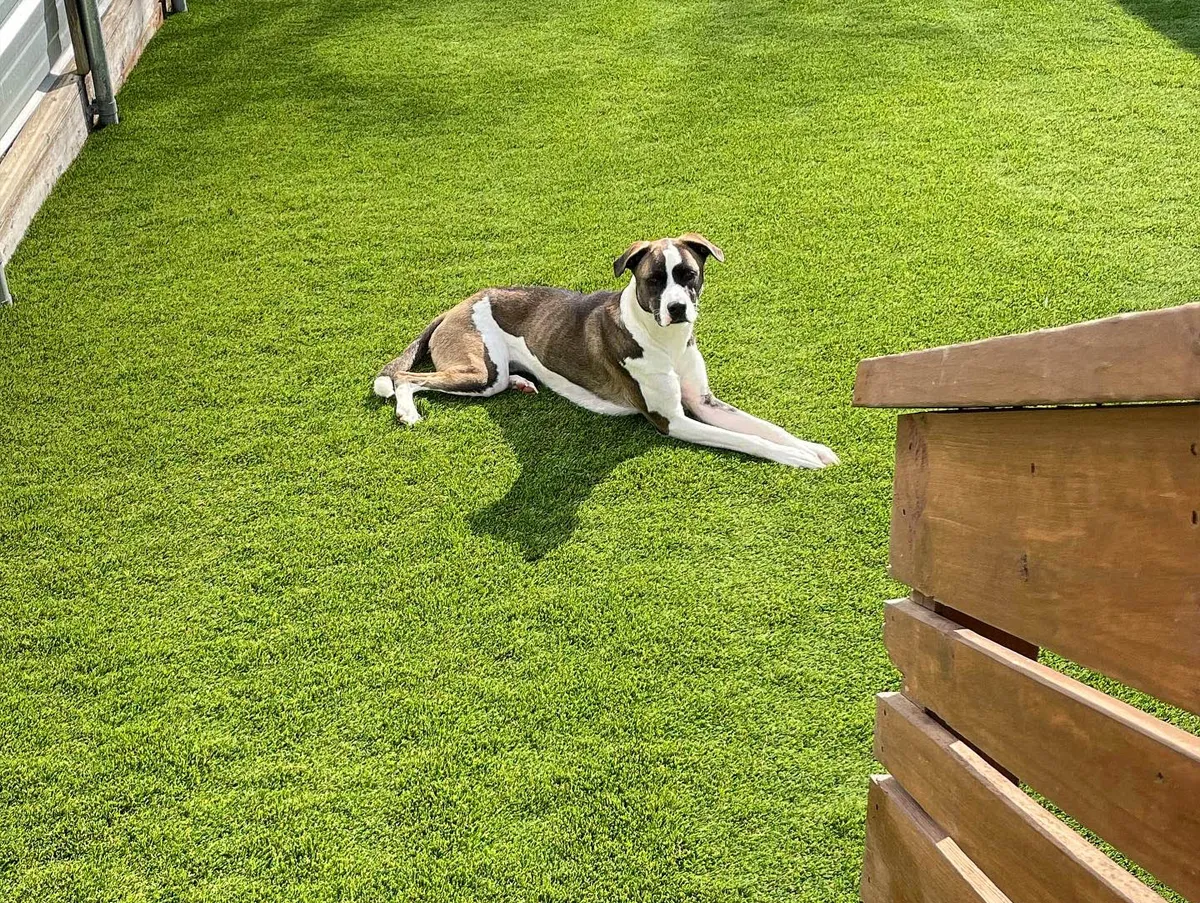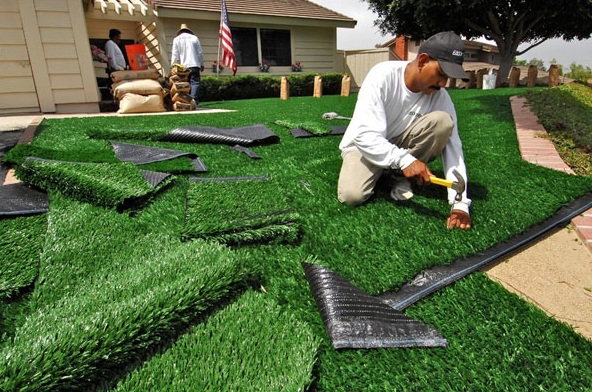See Why Homeowners Prefer Artificial Lawn for Lasting Landscaping Practices
As house owners progressively focus on sustainability in landscaping, synthetic grass has become a compelling alternative to traditional grass. Its ability to preserve water, lower upkeep initiatives, and reduce environmental impact positions it as a practical selection for those looking for eco-friendly solutions. The visual charm and flexibility of artificial lawn cater to diverse layout choices. However, the effects of this change extend past simple comfort and looks, triggering a better evaluation of just how these selections influence broader environmental results. What remains to be discovered is the full range of benefits that man-made turf can use to homeowners and the setting alike.
Water Conservation Conveniences
One of the most considerable benefits of synthetic grass is its function in water preservation. Traditional turf lawns call for significant quantities of water to maintain their lush appearance, usually resulting in overuse of regional water sources, specifically in deserts. On the other hand, synthetic grass removes this need totally, as it does not call for watering. This not just conserves water but also decreases the strain on local water supply, especially throughout dry spell problems.
Furthermore, the installation of synthetic grass can add to an extra lasting landscape. Home owners can significantly lower their water costs, permitting reallocation of sources to various other environmental initiatives or home uses. Additionally, synthetic grass is made to hold up against numerous weather conditions without the need for supplemental watering, making it an optimal choice for areas facing water deficiency.
The environmental advantages extend past prompt water financial savings. By decreasing water consumption, synthetic grass helps to minimize the effects of climate adjustment, protecting important communities that are intimidated by extreme water extraction. As lasting landscaping practices get grip, synthetic grass arises as a responsible selection for property owners seeking to produce environmentally friendly outdoor rooms.
Minimized Upkeep Efforts
Synthetic grass substantially reduces maintenance initiatives contrasted to standard yard yards. With man-made yard, home owners can get rid of the taxing tasks connected with all-natural landscaping, such as mowing, fertilizing, and weeding. This not just conserves important time yet also decreases physical labor, making grass care available for people of every ages.
Conventional lawns require regular trimming to maintain a visually pleasing height, whereas synthetic grass stays constantly lavish without the requirement for reducing. Furthermore, home owners no much longer require to use plant foods or chemicals, which are frequently needed to keep natural turf healthy.
Additionally, synthetic grass is sturdy and durable, needing minimal upkeep beyond occasional cleaning and washing to eliminate debris. This ease of upkeep enables property owners to enjoy their exterior areas without the continuous worry of maintenance, supplying more time for recreation and family members activities. Inevitably, the lowered maintenance initiatives connected with artificial lawn make it an attractive choice for those seeking a low-maintenance, visually my sources appealing landscape.

Environmental Effect Reduction
There is an expanding acknowledgment of the ecological advantages related to synthetic grass, especially in terms of water conservation and minimized chemical usage. Typical lawns require considerable amounts of water, particularly in drought-prone areas, bring about increased strain on local water sources. In contrast, synthetic grass eliminates the need for irrigation, considerably decreasing water usage and promoting sustainability.
Additionally, conventional lawn upkeep often entails the application of herbicides, fertilizers, and pesticides, which can add to soil and water pollution. Synthetic grass minimizes see this ecological danger by needing minimal maintenance and basically removing the requirement for hazardous chemicals. This not only boosts soil health yet additionally secures regional environments from harmful runoff.
In addition, the manufacturing of natural yard yards normally includes using nonrenewable fuel sources for cutting and landscaping tools, additional contributing to greenhouse gas emissions. By picking synthetic turf, homeowners can substantially lower their carbon impact connected with lawn treatment activities.
Visual Charm and Adaptability
In enhancement to its ecological advantages, synthetic grass offers considerable visual appeal and convenience for landscaping. House owners can attain a lush, green appearance year-round, getting rid of the seasonal variations commonly linked with all-natural lawn. This regular visual not only enhances the visual charm of a property but additionally adds to a properly maintained and sleek appearance.
In addition, fabricated turf is readily available in a range of textures, colors, and styles, enabling customization to suit individual choices and layout motifs - Arizona artificial turf. Whether made use of in household yards, industrial spaces, or recreational areas, it can flawlessly incorporate into diverse landscape design layouts, from modern-day minimalist to lush exotic setups
The adaptability of synthetic grass extends past simple appearance; it can be mounted in different places, including roofs, outdoor patios, and even indoor rooms, producing opportunities for unique landscape design options. Furthermore, it is suitable for a variety of tasks, from kids's backyard to pet-friendly settings, offering functionality without endangering style.
Ultimately, the visual charm and versatility of synthetic grass make it an attractive choice for homeowners looking for sustainable landscape design remedies that do not compromise click for source appeal for environmental responsibility.

Long-Term Expense Financial Savings
One of the most compelling advantages of man-made lawn is its potential for long-term expense savings. Unlike natural grass, which needs routine maintenance-- consisting of mowing, watering, feeding, and bug control-- man-made turf dramatically minimizes these ongoing expenditures.
Furthermore, synthetic lawn has a life expectancy of 15 to 25 years, depending on its top quality and usage. This resilience decreases replacement prices, making it a much more affordable option over time. The first financial investment in synthetic grass can frequently be recovered through the cost savings accumulated over time.
While the ahead of time price may seem higher contrasted to sod setup, the collective savings from minimized upkeep and water usage commonly surpass these initial expenses. Inevitably, the adoption of synthetic grass not only promotes a sustainable landscape design remedy but likewise supplies homeowners a financially smart alternative that straightens with long-term budgeting goals.
Final Thought
Man-made lawn emerges as a compelling choice for lasting landscape design, supplying substantial advantages in water conservation, decreased upkeep initiatives, and lessened environmental impact. Its aesthetic charm and adaptability boost the visual landscape while aligning with contemporary sustainability objectives. In addition, long-term cost savings contribute to its beauty for house owners. As areas significantly prioritize eco-friendly methods, the fostering of synthetic grass stands for a dynamic action towards attaining durable and sustainable landscapes.
Additionally, fabricated grass is designed to hold up against different climatic problems without the need for supplemental watering, making it an ideal selection for regions facing water deficiency. (Artificial turf companies phoenix)

Fabricated lawn emerges as a compelling alternative for lasting landscaping, offering substantial benefits in water conservation, reduced upkeep initiatives, and decreased environmental influence.